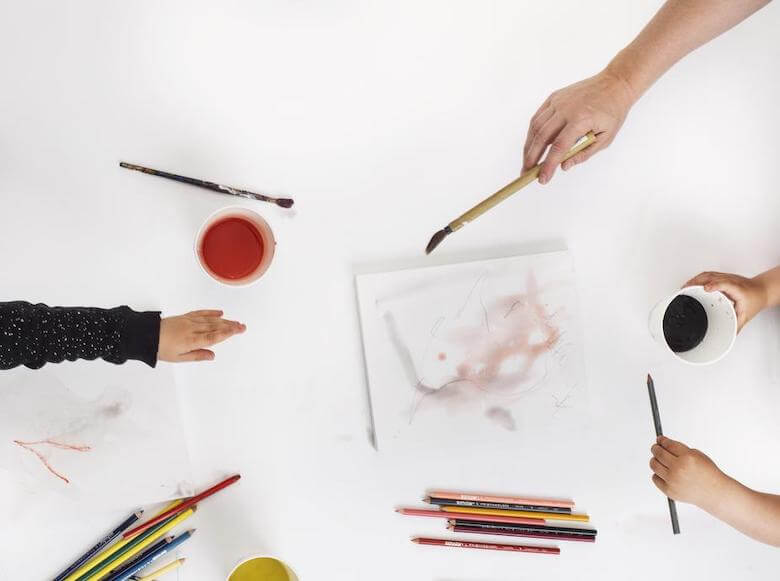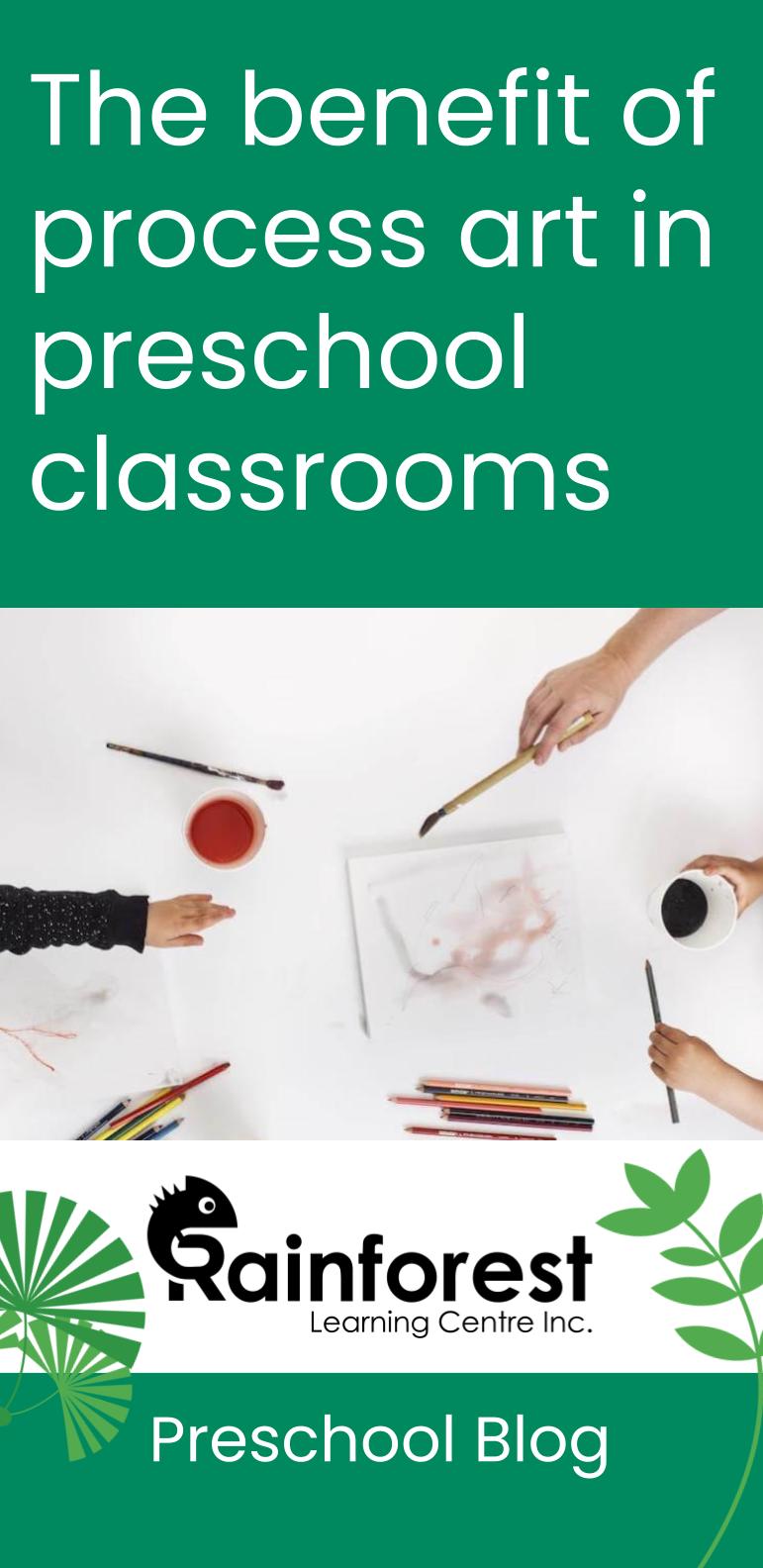
What is the benefit of process art in preschool? We think we can answer that by putting you in the shoes of a 4-year-old (which we all are, at heart!).
Imagine walking into an art studio that is full of every artistic material you can imagine: paint, string, clay, glitter, sand, canvas, cloth, beads, wood – in every colour and shape, and with all the tools you need to use those materials. Now imagine someone told you, while in that room, “you can make whatever you want, and you can use anything you see in this room, without limit – no time limit, no cost limit – just create.” Can you feel the excitement? Are you deciding in your head what you might want to make?
In contrast, imagine you walk into that room, and instead of limitless art supplies, you find a preset package of materials, instructions on how to put them together, and a sample of the finished product that has been made by a renowned artist. Which, by the way, you’re supposed to duplicate exactly as-is, and with only minor variation.
Daunting, isn’t it? While it may be inspiring, or positively challenging, or something to pass the time, we can admit it’s not quite the same as letting you decide what your heart wants to express.
We hope we’ve painted the picture (get it?) of what a child feels like when they are presented with art as a task, versus being invited to create something with freedom of expression. Aside from the difference in learning outcomes (which we’ll get into), it’s pretty obvious one of these scenarios is way more fun than the other.
Now, both are useful (and we do plenty of prepared, product-art activities in our preschool and daycare classrooms). But thinking about process art versus product art helps us realize that the point of these activities is the learning that happens ‘in between’; it’s not about the end result.
Practicing process art more often can even make product art more meaningful, and fun. The children, and the teachers, will begin to ‘think’ about preschool art differently (or so we hope).
What is process art and why is it useful in preschool classrooms?
To define this more concretely, we can say that process art is a child-directed (or, student-directed) way of doing art. The preschool teacher, and the classroom environment, are meant to provide the ‘enrichment’ and support – not the instruction. The idea is to encourage independence in a child by showing them that they can pick, choose, and decide on their own. The world is their oyster, so to speak.
In this environment, the paint, paint brushes, paper, sand, glitter, glue, tissue, stamps, scissors and everything a child needs to make their own art, in whatever way they want, is made available to them.
The preschool teacher encourages the child while they are on their journey of creation, by giving positive feedback. For example, they may point things out to help the child understand their own discoveries.
E.g. “you just mixed yellow and blue, and now you have green!” Or, “look what happened when you got paint on that string and then dragged it across your paper! It looks like swirly water splashes!” and so on.
The preschool teacher may even make passive suggestions, such as: “hmmm, what happens when we use this leaf as a paint brush?” or, “that glitter is beaaauuutiful! Should we add glue to make sure it sticks better?”
The child can say no to these suggestions – and that’s ok! The idea is to guide not to control the art process.
The benefits of process art in preschool – for early childhood educators and learners
What’s so great about process art? There are many reasons. For the early childhood educator, it means less preparation and an ‘ease of mind’ when it comes to outcome. It’s ok if a child doesn’t complete the art lesson exactly as planned. This type of emergent curriculum method means that, like play, art can be open-ended. The preschool teacher can be more focused, and spend more energy, on tracking the child’s mindful thoughts and indications.
For the child, the benefits of process art in preschool abound even further. For example:
- They worry less about meeting expectations, or having their end-product look like someone else’s. There is less comparison, and thus, less insecurity. They are less likely to give up this way, too.
- They get an end-product they can be proud of. They feel like they’ve accomplished something that is meaningful to them. It’s actually pretty amazing to see what these little minds can do, when the ‘lines’ are not ‘drawn’ for them (pun intended).
- They get to focus on what interests them the most, and then fully hone that skill, at their own pace. Process art is not without planning, prediction, and building upon prior knowledge – it’s just that the child does it, even if they don’t know they are doing it. For example: deciding to mix colours, splatter paint, draw with a finger, ooze glitter in glue – it may seem messy and random, but a child is carefully observing what their actions are creating. Eventually, through repetition, they learn to control those lines, shapes, tones, shades and so on. Not because someone told them to, but because they want to. This is a great way to develop fine motor skills, too.
- They can explore new outcomes. By using new materials, and experimenting on their own, they make memorable discoveries, like the little ‘scientists’ they are.
- They can use art experiences to develop language and meaning. E.g. they learn what ‘green’ is when they mix yellow and blue. They learn the phrase, “shiny sand” and the object name, “paint brush” and so on. And then, these are not just words, they are applicable, useful nouns they can communicate thoughts with.
- They get to relax and be calm in a joyful way. Process art is a wonderful way to enjoy ‘down time’ or simply to get ‘in the zone’ where we humans like to go in our minds. It’s an imaginative and contemplative experience to do process art.
To conclude: process art in preschools can teach a lot more than art!
Preschoolers doing process art is probably the best example of ‘art for art’s sake.’ It’s not for the end result of art, though, it’s about the ‘sake’ of ‘doing’ art. The journey itself is the process. Children learn a lot – from fine motor skills, to colour theory, to scientific outcomes, language vocabulary and even relaxation.
If you’re a parent or preschool teacher who is feeling ‘out of ideas’ when it comes to planning your classroom’s day, try process art! Those kiddos are wonderful teachers themselves! They might even teach you a thing or two about making something beautiful! Or, about noticing the magnificence of the ordinary things all around us.
Sources referenced for this article:
https://www.naeyc.org/resources/pubs/tyc/feb2014/process-art-experiences
https://tinkerlab.com/what-is-process-art-for-kids/
